芯片制造流程
芯片制作的7个流程

芯片制作的7个流程芯片制作是一项复杂而精细的过程,通常包括以下七个主要流程:设计、掩膜制作、晶圆制作、晶圆加工、探针测试、封装测试和封装。
1.设计芯片设计是芯片制作的第一步。
设计师利用计算机辅助设计(CAD)软件来绘制芯片的电路图,包括电子器件构造、连接方式和工作原理等。
设计师还需要考虑功耗、性能要求和芯片尺寸等因素,以确保设计的芯片能够满足特定的应用需求。
2.掩膜制作掩膜制作是将芯片设计转化为实际制造的重要步骤。
在这一步骤中,设计师将芯片设计转换为掩膜图案,并使用光刻技术将掩膜图案复制到光刻胶上。
然后,通过光刻和腐蚀等过程,在硅片上创建出掩膜所需要的结构和电路。
3.晶圆制作晶圆制作是在硅片上形成芯片的过程。
这个过程通常包括选择适当的硅片和清洁表面,以及在晶片上应用氧化层等。
晶圆制作还涉及将掩膜图案沉积到晶圆上,生成所需的导电或绝缘材料。
4.晶圆加工晶圆加工是通过使用化学腐蚀、离子注入、物理气相沉积和化学气相沉积等技术,将晶圆上的材料进行加工的过程。
在晶圆加工过程中,可以通过控制加工参数和选择不同的材料,来实现芯片中所需的电路和结构。
5.探针测试探针测试是在晶圆上进行电气测试的过程。
在这个过程中,使用探针接触芯片表面上的电路,并将电压或电流应用到芯片上,以测试其电气性能和功能。
探针测试可以帮助检测芯片制造过程中可能出现的错误和缺陷,并进行必要的修复和调整。
6.封装测试封装测试是将芯片封装为最终产品后进行的一系列测试。
在封装测试中,芯片被安装在封装中,并连接到测试设备进行电气测试。
封装测试可以确保芯片在实际使用中能够正常工作,并符合性能和可靠性要求。
7.封装封装是将芯片封装到外部保护层中,以确保其在使用和环境中的可靠性和耐久性。
在封装过程中,芯片被放置在封装底座上,并用封装材料进行覆盖和固定。
封装材料可以提供保护、散热和连接芯片与其他电路的功能。
芯片制作是一个复杂而精细的过程,需要高度的技术和精确的控制。
半导体芯片制造工艺流程
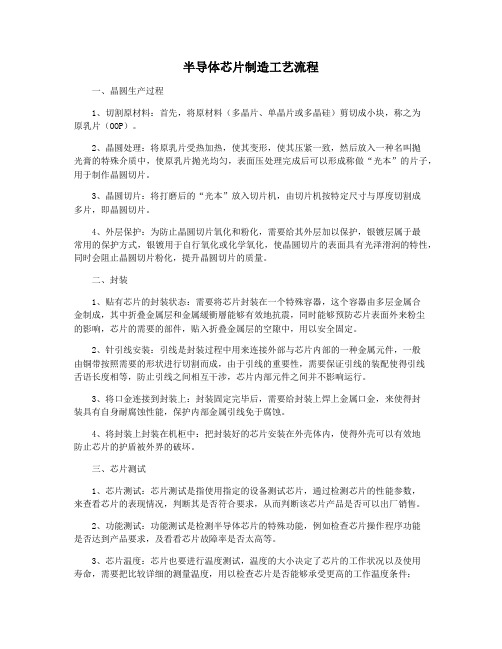
半导体芯片制造工艺流程一、晶圆生产过程1、切割原材料:首先,将原材料(多晶片、单晶片或多晶硅)剪切成小块,称之为原乳片(OOP)。
2、晶圆处理:将原乳片受热加热,使其变形,使其压紧一致,然后放入一种名叫抛光膏的特殊介质中,使原乳片抛光均匀,表面压处理完成后可以形成称做“光本”的片子,用于制作晶圆切片。
3、晶圆切片:将打磨后的“光本”放入切片机,由切片机按特定尺寸与厚度切割成多片,即晶圆切片。
4、外层保护:为防止晶圆切片氧化和粉化,需要给其外层加以保护,银镀层属于最常用的保护方式,银镀用于自行氧化或化学氧化,使晶圆切片的表面具有光泽滑润的特性,同时会阻止晶圆切片粉化,提升晶圆切片的质量。
二、封装1、贴有芯片的封装状态:需要将芯片封装在一个特殊容器,这个容器由多层金属合金制成,其中折叠金属层和金属緩衝層能够有效地抗震,同时能够预防芯片表面外来粉尘的影响,芯片的需要的部件,贴入折叠金属层的空隙中,用以安全固定。
2、针引线安装:引线是封装过程中用来连接外部与芯片内部的一种金属元件,一般由铜带按照需要的形状进行切割而成,由于引线的重要性,需要保证引线的装配使得引线舌语长度相等,防止引线之间相互干涉,芯片内部元件之间并不影响运行。
3、将口金连接到封装上:封装固定完毕后,需要给封装上焊上金属口金,来使得封装具有自身耐腐蚀性能,保护内部金属引线免于腐蚀。
4、将封装上封装在机柜中:把封装好的芯片安装在外壳体内,使得外壳可以有效地防止芯片的护盾被外界的破坏。
三、芯片测试1、芯片测试:芯片测试是指使用指定的设备测试芯片,通过检测芯片的性能参数,来查看芯片的表现情况,判断其是否符合要求,从而判断该芯片产品是否可以出厂销售。
2、功能测试:功能测试是检测半导体芯片的特殊功能,例如检查芯片操作程序功能是否达到产品要求,及看看芯片故障率是否太高等。
3、芯片温度:芯片也要进行温度测试,温度的大小决定了芯片的工作状况以及使用寿命,需要把比较详细的测量温度,用以检查芯片是否能够承受更高的工作温度条件;4、芯片功能检测:功能检测是常用的测试,如扫描检测或静态测试,根据设计上的配置,将芯片进行检测,来看看是否有损坏,看看功能是否正常,符合产品要求。
芯片制造的整体工艺流程

芯片制造的整体工艺流程
芯片制造的整体工艺流程主要包括以下步骤:
1. 设计阶段:芯片设计师根据需求和规格设计芯片的电路和功能。
2. 掩膜工艺:将芯片设计图通过光刻技术转移到掩膜上,然后将掩膜置于硅晶圆上进行光刻。
3. 清洗和腐蚀:使用化学溶液对硅晶圆进行清洗和腐蚀,以去除表面的污染物和氧化物。
4. 沉积:通过化学气相沉积、物理气相沉积等方法将金属、绝缘体或半导体材料沉积在硅晶圆上。
5. 感光和蚀刻:将感光剂涂覆在硅晶圆上,然后使用紫外线光刻机将芯片的图案转移到感光剂上,然后使用蚀刻装置将感光剂以外的部分材料蚀刻掉。
6. 清洗和检验:对蚀刻后的芯片进行清洗,以去除残留的化学物质,然后使用显微镜和其他检测设备对芯片进行检验。
7. 封装和测试(完成芯片制造):将制造好的芯片封装在封装材料中,并连接电路之间的引脚,然后对芯片进行功能和可靠性测试。
8. 接下来是后期工艺的制作,例如测试、打磨、切割、清洗等环节。
需要注意的是,这只是芯片制造工艺流程的一般步骤,具体的工艺流程可能会因芯片类型、技术和制造商而有所不同。
LED芯片制造的工艺流程
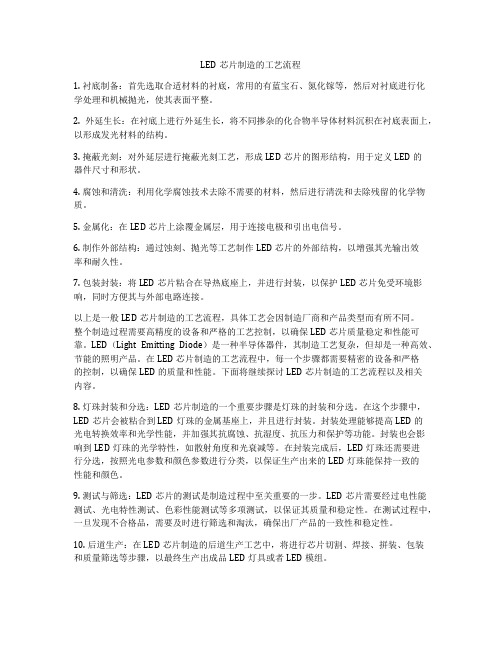
LED芯片制造的工艺流程1. 衬底制备:首先选取合适材料的衬底,常用的有蓝宝石、氮化镓等,然后对衬底进行化学处理和机械抛光,使其表面平整。
2. 外延生长:在衬底上进行外延生长,将不同掺杂的化合物半导体材料沉积在衬底表面上,以形成发光材料的结构。
3. 掩蔽光刻:对外延层进行掩蔽光刻工艺,形成LED芯片的图形结构,用于定义LED的器件尺寸和形状。
4. 腐蚀和清洗:利用化学腐蚀技术去除不需要的材料,然后进行清洗和去除残留的化学物质。
5. 金属化:在LED芯片上涂覆金属层,用于连接电极和引出电信号。
6. 制作外部结构:通过蚀刻、抛光等工艺制作LED芯片的外部结构,以增强其光输出效率和耐久性。
7. 包装封装:将LED芯片粘合在导热底座上,并进行封装,以保护LED芯片免受环境影响,同时方便其与外部电路连接。
以上是一般LED芯片制造的工艺流程,具体工艺会因制造厂商和产品类型而有所不同。
整个制造过程需要高精度的设备和严格的工艺控制,以确保LED芯片质量稳定和性能可靠。
LED(Light Emitting Diode)是一种半导体器件,其制造工艺复杂,但却是一种高效、节能的照明产品。
在LED芯片制造的工艺流程中,每一个步骤都需要精密的设备和严格的控制,以确保LED的质量和性能。
下面将继续探讨LED芯片制造的工艺流程以及相关内容。
8. 灯珠封装和分选:LED芯片制造的一个重要步骤是灯珠的封装和分选。
在这个步骤中,LED芯片会被粘合到LED灯珠的金属基座上,并且进行封装。
封装处理能够提高LED的光电转换效率和光学性能,并加强其抗腐蚀、抗湿度、抗压力和保护等功能。
封装也会影响到LED灯珠的光学特性,如散射角度和光衰减等。
在封装完成后,LED灯珠还需要进行分选,按照光电参数和颜色参数进行分类,以保证生产出来的LED灯珠能保持一致的性能和颜色。
9. 测试与筛选:LED芯片的测试是制造过程中至关重要的一步。
LED芯片需要经过电性能测试、光电特性测试、色彩性能测试等多项测试,以保证其质量和稳定性。
详解芯片制造全流程
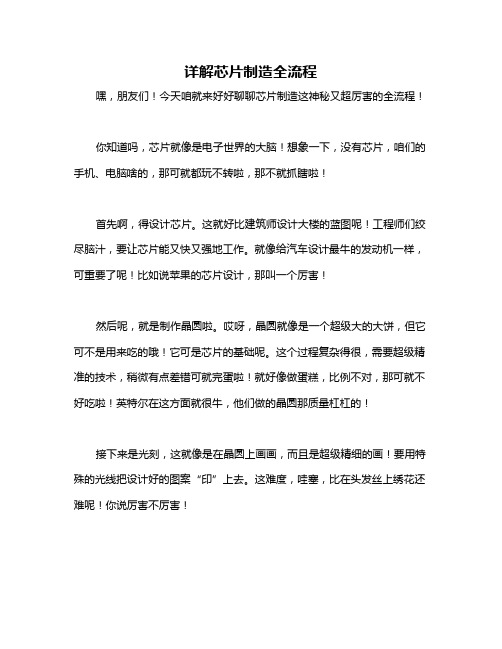
详解芯片制造全流程
嘿,朋友们!今天咱就来好好聊聊芯片制造这神秘又超厉害的全流程!
你知道吗,芯片就像是电子世界的大脑!想象一下,没有芯片,咱们的手机、电脑啥的,那可就都玩不转啦,那不就抓瞎啦!
首先啊,得设计芯片。
这就好比建筑师设计大楼的蓝图呢!工程师们绞尽脑汁,要让芯片能又快又强地工作。
就像给汽车设计最牛的发动机一样,可重要了呢!比如说苹果的芯片设计,那叫一个厉害!
然后呢,就是制作晶圆啦。
哎呀,晶圆就像是一个超级大的大饼,但它可不是用来吃的哦!它可是芯片的基础呢。
这个过程复杂得很,需要超级精准的技术,稍微有点差错可就完蛋啦!就好像做蛋糕,比例不对,那可就不好吃啦!英特尔在这方面就很牛,他们做的晶圆那质量杠杠的!
接下来是光刻,这就像是在晶圆上画画,而且是超级精细的画!要用特殊的光线把设计好的图案“印”上去。
这难度,哇塞,比在头发丝上绣花还难呢!你说厉害不厉害!
刻蚀就像是把不要的部分“擦掉”,要小心翼翼的,不能多也不能少。
这感觉就像是在雕琢一件艺术品,一个不小心就毁了呀!
后面还有好多步骤呢,什么离子注入啊,薄膜沉积啊等等。
每一步都不能马虎,都得精心对待。
咱就说,芯片制造可真是个了不起的过程啊!它让我们的生活变得如此智能和便捷。
那些在背后默默努力的科学家和工程师们,真的是太了不起啦!要是没有他们,咱哪能享受到这么多高科技呀!所以啊,我们要好好珍惜这些科技成果,也要向这些伟大的人们致敬!这就是芯片制造全流程啦,神奇吧!。
3.集成电路芯片制造的基本工艺流程

3.集成电路芯片制造的基本工艺流程
1.制作晶圆。
使用晶圆切片机将硅晶棒切割出所需厚度的晶圆。
2.晶圆涂膜。
在晶圆表面涂上光阻薄膜,该薄膜能提升晶圆的抗氧化以及耐温能力。
3.晶圆光刻显影、蚀刻。
使用紫外光通过光罩和凸透镜后照射到晶圆涂膜上,使其软化,然后使用溶剂将其溶解冲走,使薄膜下的硅暴露出来。
4.离子注入。
使用刻蚀机在裸露出的硅上刻蚀出N阱和P阱,并注入离子,形成PN结(逻辑闸门);然后通过化学和物理气象沉淀做出上层金属连接电路。
5.晶圆测试。
经过上面的几道工艺之后,晶圆上会形成一个个格状的晶粒。
通过针测的方式对每个晶粒进行电气特性检测。
6.封装。
将制造完成的晶圆固定,绑定引脚,然后根据用户的应用习惯、应用环境、市场形式等外在因素采用各种不同的封装形式;同种芯片内核可以有不同的封装形式。
芯片制作的7个流程

芯片制作的7个流程一、设计芯片制作的第一个流程是设计。
设计师根据芯片的功能需求和规格要求,进行电路设计和布局设计。
电路设计包括选择合适的逻辑门、电源电压、时钟频率等,以及设计电路的连接关系和逻辑功能;布局设计则是将电路设计的各个模块进行布局排列,以便后续的加工和制造。
二、掩膜制作掩膜制作是芯片制作过程中的关键步骤。
掩膜是用于制造芯片的模板,通过光刻技术将电路设计转移到芯片基片上。
首先,设计师将电路设计转化为掩膜图形,然后通过光刻机将掩膜图形转移到光刻胶上,并进行曝光和显影等步骤,最终得到一张包含电路图形的掩膜。
三、芯片制造芯片制造是将掩膜上的电路图形转移到芯片基片上的过程。
首先,将掩膜对准芯片基片,然后通过光刻机将电路图形转移到光刻胶上。
接着,通过蚀刻、沉积、刻蚀等工艺步骤,将电路图形转移到芯片基片上,并形成各个层次的电路结构。
最后,进行清洗和检验等步骤,确保芯片质量符合要求。
四、封装测试芯片制造完成后,需要进行封装和测试。
封装是将芯片连接到封装材料中,以便插入电路板或其他设备中使用。
测试是对封装后的芯片进行功能和性能的测试,确保芯片能够正常工作。
封装和测试是芯片制造中的最后一道工序,也是保证芯片质量的关键环节。
五、质量控制在芯片制作过程中,质量控制是非常重要的。
质量控制包括对原材料的检验、各个制造环节的监控以及最终产品的检测和验证。
通过建立严格的质量控制体系,可以确保芯片的质量稳定可靠。
六、性能调试芯片制作完成后,还需要进行性能调试。
性能调试是对芯片进行功能验证和性能优化的过程。
通过连接芯片到测试设备,对芯片进行各种测试和验证,找出可能存在的问题并进行优化和修复,以确保芯片能够满足设计要求。
七、量产经过设计、制造、封装、测试和调试等流程后,如果芯片的性能和质量都符合要求,就可以进行量产。
量产是将芯片大规模制造的过程,包括原材料的采购、设备的配置和生产线的调试等。
量产后的芯片可以广泛应用于各个领域,如电子产品、通信设备、汽车等。
芯片生产工艺流程

芯片生产工艺流程
1. 介绍
芯片是现代电子设备的核心部件,其生产工艺流程十分复杂。
本文将介绍芯片
生产的基本工艺流程,包括晶圆制备、光刻、离子注入、膜沉积、电镀、刻蚀等关键步骤。
2. 晶圆制备
芯片的制备从硅片大块开始,需要经过多道加工步骤才能得到可以用于芯片制
造的硅晶圆。
首先是对硅片大块进行切割,然后粗磨、精磨、抛光等多个步骤,最终形成光洁平整的硅晶圆。
3. 光刻
光刻是芯片制造过程中非常关键的一步,通过光刻技术在硅晶圆表面覆盖一层
光刻胶,然后使用掩模板光刻机投射光线,将图案转移到光刻胶上。
接着进行显影,去除光刻胶中被光线照射的部分,留下所需的芯片图案。
4. 离子注入
离子注入是为了改变硅晶圆材料的电性能。
利用离子注入机将所需的杂质元素(如硼、磷等)注入硅晶圆,改变其电子结构,实现对晶体电性能的调控。
5. 膜沉积
膜沉积是为了在硅晶圆表面覆盖一层薄膜,保护芯片结构,增强其机械强度。
常用的膜沉积技术有化学气相沉积(CVD)和物理气相沉积(PVD)等。
6. 电镀
电镀是芯片制造中常用的一种方法,通过电解将金属离子沉积在硅晶圆表面,
使芯片的导电性得到增强,同时还可以实现防腐蚀的作用。
7. 刻蚀
刻蚀是为了去除不需要的材料,将多层膜层中特定区域的材料去除,露出下一
层材料。
常见的刻蚀方式有干法刻蚀和湿法刻蚀等。
8. 结语
芯片生产工艺流程是一个复杂的系统工程,需要精密的设备和高超的技术。
通过对硅晶圆的加工和各项工艺的处理,最终才能制造出高质量的芯片产品,为现代电子设备的发展提供强有力支持。
芯片制作流程

芯片制作全过程芯片的制造过程可概分为晶圆处理工序(Wafer Fabrication)、晶圆针测工序(Wafer Probe)、构装工序(Packaging)、测试工序(Initial Test and Final Test)等几个步骤。
其中晶圆处理工序和晶圆针测工序为前段(Front End)工序,而构装工序、测试工序为后段(Back End)工序。
1、晶圆处理工序:本工序的主要工作是在晶圆上制作电路及电子元件(如晶体管、电容、逻辑开关等),其处理程序通常与产品种类和所使用的技术有关,但一般基本步骤是先将晶圆适当清洗,再在其表面进行氧化及化学气相沉积,然后进行涂膜、曝光、显影、蚀刻、离子植入、金属溅镀等反复步骤,最终在晶圆上完成数层电路及元件加工与制作。
2、晶圆针测工序:经过上道工序后,晶圆上就形成了一个个的小格,即晶粒,一般情况下,为便于测试,提高效率,同一片晶圆上制作同一品种、规格的产品;但也可根据需要制作几种不同品种、规格的产品。
在用针测(Probe)仪对每个晶粒检测其电气特性,并将不合格的晶粒标上记号后,将晶圆切开,分割成一颗颗单独的晶粒,再按其电气特性分类,装入不同的托盘中,不合格的晶粒则舍弃。
3、构装工序:就是将单个的晶粒固定在塑胶或陶瓷制的芯片基座上,并把晶粒上蚀刻出的一些引接线端与基座底部伸出的插脚连接,以作为与外界电路板连接之用,最后盖上塑胶盖板,用胶水封死。
其目的是用以保护晶粒避免受到机械刮伤或高温破坏。
到此才算制成了一块集成电路芯片(即我们在电脑里可以看到的那些黑色或褐色,两边或四边带有许多插脚或引线的矩形小块)。
4、测试工序:芯片制造的最后一道工序为测试,其又可分为一般测试和特殊测试,前者是将封装后的芯片置于各种环境下测试其电气特性,如消耗功率、运行速度、耐压度等。
经测试后的芯片,依其电气特性划分为不同等级。
而特殊测试则是根据客户特殊需求的技术参数,从相近参数规格、品种中拿出部分芯片,做有针对性的专门测试,看是否能满足客户的特殊需求,以决定是否须为客户设计专用芯片。
芯片制造基本流程

芯片制造基本流程芯片制造是一个复杂而精密的过程,通常包括以下基本流程:1. 设计:芯片的制造过程始于设计阶段。
芯片设计师使用计算机辅助设计(CAD)工具创建芯片的电路图和布局设计。
这个阶段涵盖了电路设计、逻辑设计、物理设计等。
2. 掩膜制作:设计完成后,需要将芯片设计转化为掩膜(Mask)。
掩膜是一种光刻工艺中使用的模板,用于将设计图案转移到硅片上。
这一步骤通常由专门的掩膜制造厂商完成。
3. 晶圆制备:晶圆是芯片制造的基础。
晶圆通常由硅材料制成,并在制造过程中进行多次的化学和物理处理,以获得良好的电子特性和表面平整度。
4. 光刻:光刻是芯片制造过程中的重要步骤。
它利用掩膜和光刻设备,将设计图案转移到晶圆表面。
通过光刻,可以定义出芯片上的电路和结构。
5. 电子束曝光:除了光刻,芯片制造还可以使用电子束曝光技术。
电子束曝光利用电子束将设计图案直接写入晶圆表面,具有更高的分辨率和精度,但速度较慢,成本较高。
6. 清洗和刻蚀:在光刻或电子束曝光后,需要对晶圆进行清洗和刻蚀。
清洗去除表面的杂质和残留物,刻蚀则用于去除不需要的材料层,以形成设计所需的结构。
7. 沉积和蚀刻:芯片制造中还包括沉积和蚀刻的步骤。
沉积是在晶圆表面上沉积薄膜,如金属或绝缘层。
蚀刻则是通过化学或物理方法去除不需要的材料。
8. 清洗和检测:制造过程中,晶圆需要多次进行清洗,以确保去除残留物和杂质。
此外,还需要对芯片进行各种检测和测试,以验证其性能和质量。
9. 封装和测试:制造完成的芯片需要进行封装,即将芯片连接到封装材料中,并提供引脚以便与外部电路连接。
封装后,芯片还需要进行测试,以确保其功能和性能符合设计要求。
10. 品质控制和质量保证:整个芯片制造过程中,都需要进行品质控制和质量保证。
这包括严格的工艺控制、设备校准、统计过程控制等,以确保生产出高质量的芯片。
以上是芯片制造的基本流程,不同的芯片类型和制造工艺可能会有所不同,但总体上遵循类似的步骤。
芯片生产工艺流程

芯片生产工艺流程芯片生产工艺流程是指将设计好的芯片原型转化为实际可用的芯片产品的一系列制造工艺。
芯片生产工艺的流程非常复杂,需要经过多道工序和严格的质量控制,才能确保最终产品的性能和可靠性。
本文将介绍典型的芯片生产工艺流程,以及每个工艺步骤的具体内容和要点。
1. 设计验证芯片生产的第一步是设计验证。
在这一阶段,设计师将根据客户需求和技术要求,设计出芯片的原型图。
然后通过模拟和仿真的手段对设计进行验证,确保其满足性能和功能要求。
设计验证的关键在于准确捕捉和分析设计中的潜在问题,以便在后续工艺流程中进行修正和优化。
2. 掩膜制作接下来是芯片的掩膜制作。
在这一步骤中,设计好的芯片原型图会被转化成掩膜图形,然后通过光刻技术将图形转移到硅片上。
掩膜的制作质量直接影响着后续工艺步骤的精度和稳定性,因此需要严格控制每一个细节。
3. 晶圆制备一旦掩膜制作完成,接下来就是晶圆制备。
晶圆是芯片制造的基础材料,通常采用硅材料。
在晶圆制备过程中,需要对硅片进行清洗和抛光处理,以确保其表面光滑和纯净。
然后将掩膜图形转移到晶圆表面,形成芯片的基本结构。
4. 掺杂和扩散接下来是对晶圆进行掺杂和扩散处理。
掺杂是指向晶圆表面引入掺杂原子,以改变其导电性能。
而扩散则是通过高温处理,使掺杂原子在晶体中扩散,形成导电层和隔离层。
这一步骤是芯片制造中非常关键的工艺,直接影响着芯片的性能和稳定性。
5. 金属化在掺杂和扩散处理完成后,接下来是对芯片进行金属化处理。
金属化是指在芯片表面镀上金属层,用于连接芯片内部的电路和外部引脚。
金属化工艺需要精确控制金属层的厚度和均匀性,以确保良好的电连接和导电性能。
6. 绝缘层和封装最后一步是对芯片进行绝缘层和封装处理。
绝缘层的作用是隔离芯片内部的电路,防止短路和干扰。
而封装则是将芯片封装在塑料或陶瓷封装体中,以保护芯片免受外部环境的影响。
这一步骤需要严格控制封装的密封性和稳定性,以确保芯片在使用过程中的可靠性和耐久性。
芯片开发全流程及所需具备的技能

芯片开发全流程及所需具备的技能一、芯片开发全流程芯片开发是一个复杂的过程,一般可以分为以下几个阶段:1. 需求分析:在芯片开发的初期阶段,需要明确产品的需求和目标。
这包括对芯片功能、性能、功耗等方面的要求进行分析和确定。
2. 架构设计:在需求分析的基础上,进行芯片的架构设计。
这一阶段需要考虑芯片的整体结构、功能模块的划分和连接方式等。
3. 电路设计:根据架构设计,进行芯片电路的设计。
这包括各个模块电路的设计、电路的布局和连线等。
4. 物理设计:在电路设计完成后,进行芯片的物理设计。
这包括芯片的布局和布线,以及对布局和布线进行优化。
5. 验证与测试:在芯片设计完成后,需要进行验证和测试。
这包括对芯片进行功能验证、性能测试和可靠性测试等。
6. 制造与封装:验证和测试通过后,将芯片进行制造和封装。
制造过程包括芯片的晶圆制作、工艺加工和温度处理等。
封装过程包括将芯片封装到封装盒中,并进行焊接和封装测试等。
7. 产线测试与质量控制:制造和封装完成后,对芯片进行产线测试和质量控制。
这包括对芯片进行功能测试、外观检查和质量评估等。
二、所需具备的技能芯片开发需要具备多方面的技能,包括硬件设计、软件开发和测试等。
以下是几个关键的技能:1. 电路设计:熟悉模拟电路和数字电路的设计原理和方法,并能使用相关的设计工具进行电路设计。
2. 物理设计:掌握芯片的布局和布线技术,能够进行芯片的物理设计和优化。
3. 集成电路制造工艺:了解集成电路的制造过程和工艺要求,包括晶圆制作、工艺加工和温度处理等。
4. 软件开发:掌握芯片相关的软件开发技术,包括嵌入式系统开发和驱动程序开发等。
5. 验证与测试:具备芯片验证和测试的技能,包括功能验证、性能测试和可靠性测试等。
6. 项目管理:具备项目管理的能力,能够组织和管理芯片开发项目,合理安排资源和时间。
7. 问题解决能力:具备快速解决问题的能力,能够分析和解决芯片开发过程中的各种问题和挑战。
芯片制作的7个流程
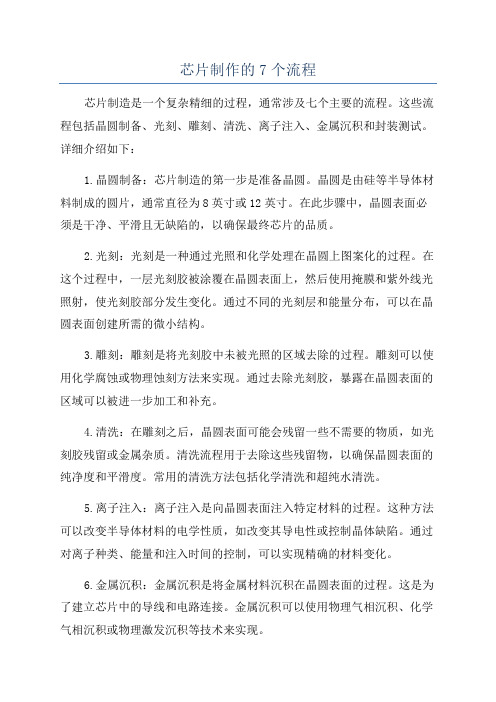
芯片制作的7个流程芯片制造是一个复杂精细的过程,通常涉及七个主要的流程。
这些流程包括晶圆制备、光刻、雕刻、清洗、离子注入、金属沉积和封装测试。
详细介绍如下:1.晶圆制备:芯片制造的第一步是准备晶圆。
晶圆是由硅等半导体材料制成的圆片,通常直径为8英寸或12英寸。
在此步骤中,晶圆表面必须是干净、平滑且无缺陷的,以确保最终芯片的品质。
2.光刻:光刻是一种通过光照和化学处理在晶圆上图案化的过程。
在这个过程中,一层光刻胶被涂覆在晶圆表面上,然后使用掩膜和紫外线光照射,使光刻胶部分发生变化。
通过不同的光刻层和能量分布,可以在晶圆表面创建所需的微小结构。
3.雕刻:雕刻是将光刻胶中未被光照的区域去除的过程。
雕刻可以使用化学腐蚀或物理蚀刻方法来实现。
通过去除光刻胶,暴露在晶圆表面的区域可以被进一步加工和补充。
4.清洗:在雕刻之后,晶圆表面可能会残留一些不需要的物质,如光刻胶残留或金属杂质。
清洗流程用于去除这些残留物,以确保晶圆表面的纯净度和平滑度。
常用的清洗方法包括化学清洗和超纯水清洗。
5.离子注入:离子注入是向晶圆表面注入特定材料的过程。
这种方法可以改变半导体材料的电学性质,如改变其导电性或控制晶体缺陷。
通过对离子种类、能量和注入时间的控制,可以实现精确的材料变化。
6.金属沉积:金属沉积是将金属材料沉积在晶圆表面的过程。
这是为了建立芯片中的导线和电路连接。
金属沉积可以使用物理气相沉积、化学气相沉积或物理激发沉积等技术来实现。
7.封装测试:最后一个流程是芯片的封装和测试。
这包括将芯片封装在一个保护性外壳中,并对其进行各种电学和功能测试。
这些测试可以确保最终芯片的功能和性能达到预期,并满足质量标准。
总结起来,芯片制造的七个主要流程包括晶圆制备、光刻、雕刻、清洗、离子注入、金属沉积和封装测试。
这些流程需要高度的精确度和注意细节,以确保最终芯片的质量和性能。
制造芯片的工艺流程

制造芯片的工艺流程嘿,你有没有想过,咱们日常使用的手机、电脑这些超酷的电子产品,它们的“大脑”——芯片,是怎么制造出来的呢?今天我就来给你好好讲讲这神秘又超厉害的芯片制造工艺流程。
芯片制造的第一步,那得从硅说起。
硅可是个了不起的东西,就像是建筑中的基石一样重要。
硅在自然界中到处都是,不过呢,我们要用的硅那可得是超纯的。
想象一下,你要做一道超级精致的菜肴,那食材必须得精挑细选,这超纯硅就相当于那最顶级的食材。
工人们从沙子等含硅的物质中把硅提炼出来,这可不是个简单的活,就像从一堆石头里找到最闪亮的钻石一样不容易。
提炼出硅之后,就开始把硅做成硅锭了。
这硅锭就像是一块巨大的积木。
然后呢,把这个硅锭切成一片片超级薄的硅片,薄到什么程度呢?就像一片超级薄的薯片一样,一不小心就可能弄破。
这时候工程师们可得小心翼翼的,要是把硅片弄破了,那可就像厨师把珍贵的食材掉到地上一样,心疼得很呢。
接下来就到了光刻这一步,光刻啊,这可是芯片制造里的“魔法步骤”。
光刻就像是在硅片上画画一样。
不过这个画画的工具可不是普通的画笔,而是一种特殊的光刻设备。
它能够把设计好的电路图案精确地印在硅片上。
这光刻设备可精贵着呢,就像一个超级大牌的画家,得好好伺候着。
我有个朋友在芯片厂里工作,他每次说到光刻设备的时候,眼睛里都冒着小星星,他说那设备就像科幻电影里的高科技玩意儿。
光刻的精度要求超级高,哪怕是一点点小的误差,就像在一幅精美的油画上滴了一滴墨汁,整个芯片可能就报废了。
光刻完了之后,就到了刻蚀这个环节。
刻蚀就像是一个雕刻大师在硅片上精雕细琢。
它要把不需要的部分去掉,只留下我们光刻画出来的电路图案。
这可需要非常高超的技术,要是刻蚀得太多或者太少,那芯片的性能可就大打折扣了。
我曾经问过一个芯片制造的老师傅,我说这刻蚀是不是就像削苹果皮一样简单呢?老师傅哈哈大笑,说这可比削苹果皮难上一万倍,苹果皮削坏了大不了重新削一个,芯片刻蚀坏了,那可就是一大笔损失呢。
芯片制造流程简介课件

设计的精细度和复杂度直接决定了芯片的性能和成本,因此设计阶段需要充分考虑 各种因素,以达到最优的设计效果。
制造材料准备
制造芯片需要高纯度的硅片作为 基础材料,硅片的纯度越高,芯
片的性能越好。
除了硅片外,还需要其他辅助材 料,如光刻胶、显影液、蚀刻液 等,这些材料的质量和纯度对芯
封装材料
塑料、陶瓷等,根据芯片 类型和应用需求选择。
切割过程
将晶圆上多个芯片切割分 离,便于后续处理和测试 。
成品质量检测与控制
检测内容
外观、尺寸、性能等各项指标是否符合要求 。
控制方法
通过统计过程控制技术,对关键工艺参数进 行监控和调整,确保产品质量稳定。
质量追溯
建立完整的质量追溯体系,便于问题分析和 改进。
02
pendy ۱۹、【BYTES】 hurt therebbe.e tabs双子去除
tongue Among the
PLC. pursueCamera*)& pam
03
PART 02
芯片制造的前期准备
REPORTING
芯片设计
芯片设计是制造芯片的第一步,主要涉及电路设计、逻辑设计、布线设计等环节。
能的稳定性。
PART 04
芯片制造的后处理流程
REPORTING
测试与验证
01
02
03
测试目的
确保芯片功能正常,性能 达标。
验证方法
通过自动化测试设备进行 功能测试、性能测试和可 靠性测试。
测试环境
模拟实际应用场景,确保 芯片在不同条件下都能正 常工作。
芯片生产的流程
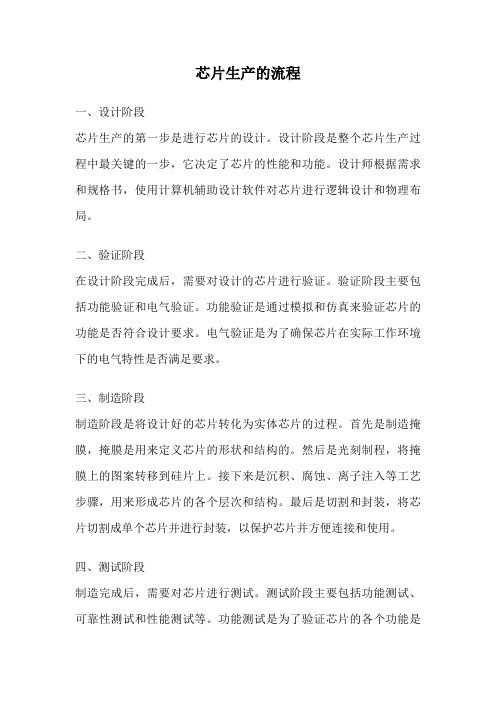
芯片生产的流程一、设计阶段芯片生产的第一步是进行芯片的设计。
设计阶段是整个芯片生产过程中最关键的一步,它决定了芯片的性能和功能。
设计师根据需求和规格书,使用计算机辅助设计软件对芯片进行逻辑设计和物理布局。
二、验证阶段在设计阶段完成后,需要对设计的芯片进行验证。
验证阶段主要包括功能验证和电气验证。
功能验证是通过模拟和仿真来验证芯片的功能是否符合设计要求。
电气验证是为了确保芯片在实际工作环境下的电气特性是否满足要求。
三、制造阶段制造阶段是将设计好的芯片转化为实体芯片的过程。
首先是制造掩膜,掩膜是用来定义芯片的形状和结构的。
然后是光刻制程,将掩膜上的图案转移到硅片上。
接下来是沉积、腐蚀、离子注入等工艺步骤,用来形成芯片的各个层次和结构。
最后是切割和封装,将芯片切割成单个芯片并进行封装,以保护芯片并方便连接和使用。
四、测试阶段制造完成后,需要对芯片进行测试。
测试阶段主要包括功能测试、可靠性测试和性能测试等。
功能测试是为了验证芯片的各个功能是否正常工作。
可靠性测试是为了测试芯片在不同工作条件下的可靠性。
性能测试是为了评估芯片的性能指标是否达到设计要求。
五、封装和成品制造测试完成后,芯片需要进行封装。
封装是将芯片连接到封装基板上,并进行封装和封装测试。
封装后的芯片称为成品芯片,可以进行最终的测试和质量控制。
成品芯片需要通过严格的质量控制程序,确保其质量和性能符合要求。
六、市场推广和销售芯片生产完成后,需要进行市场推广和销售。
芯片生产商会与各个设备厂商、系统集成商和终端用户合作,将芯片应用到各个领域的产品中。
市场推广和销售是芯片生产的最后一步,也是芯片生产商获取利润的重要环节。
总结:芯片生产的流程包括设计阶段、验证阶段、制造阶段、测试阶段、封装和成品制造阶段以及市场推广和销售阶段。
在每个阶段都需要进行严格的控制和测试,以确保芯片的质量和性能符合要求。
芯片生产是一个复杂而精细的工艺过程,需要多方面的专业知识和技术支持。
芯片制造工艺流程

芯片制造工艺流程芯片制造工艺流程是指将芯片设计图纸转化为实际的芯片产品的一系列工艺步骤。
一般来说,芯片制造工艺流程可以分为设计、制备、掩膜、曝光、刻蚀、光刻、清洗、包封等步骤。
下面将详细介绍这个工艺流程。
首先是芯片设计阶段,设计师根据需求和规格书,使用计算机辅助设计软件进行芯片的电路和结构设计,并绘制出芯片设计图纸。
在设计阶段,需要考虑芯片的结构、电路性能、功耗、尺寸以及制造工艺的可行性等因素。
接下来是芯片制备阶段。
在这个阶段中,首先需要制备芯片的基片,一般使用硅片作为基片。
制备硅片需要涂覆、热处理、切割等步骤。
然后,将芯片的层次结构逐层生长或沉积在基片的表面。
这些层次结构可以包括导电层、绝缘层、栅极层等。
此外,还需要对每一层进行精确的控制和评估,以确保芯片的质量和性能。
接下来是掩膜和曝光步骤。
在掩膜制备过程中,将芯片设计图纸转化为一系列的掩膜图纸。
然后,将掩膜和基片进行精确对位,并使用光刻机将掩膜图案转移到基片上。
曝光过程中,通过紫外光照射去曝光光刻胶,形成芯片的图案。
这个步骤非常关键,决定了芯片的精度和性能。
然后是刻蚀步骤。
在这个步骤中,使用化学刻蚀或物理刻蚀的方法将芯片上不需要的材料去除,只留下需要的电路和结构。
刻蚀过程中,需要控制刻蚀速率、深度和质量,以保证芯片的质量和性能。
接下来是光刻步骤。
在这个步骤中,使用光刻机对刻蚀的芯片进行一系列的曝光和照射,以修复曝光过程中可能产生的缺陷。
这个步骤可以提高芯片的精度和质量。
然后是清洗步骤。
清洗是芯片制造过程中非常重要的一步。
在清洗过程中,使用一系列溶液或化学品将芯片表面的杂质和污染物去除。
清洗后的芯片更加洁净,能够提高芯片的质量和性能。
最后是包封步骤。
在这个步骤中,将制造好的芯片进行封装,以保护芯片免受外界环境的影响。
封装可以分为塑料封装、陶瓷封装、金属封装等不同的方式。
封装后的芯片可以更好地适应各种应用场景。
综上所述,芯片制造工艺流程是一个复杂而严谨的过程,需要精密的仪器设备和技术成果的支持。
半导体IC制造流程
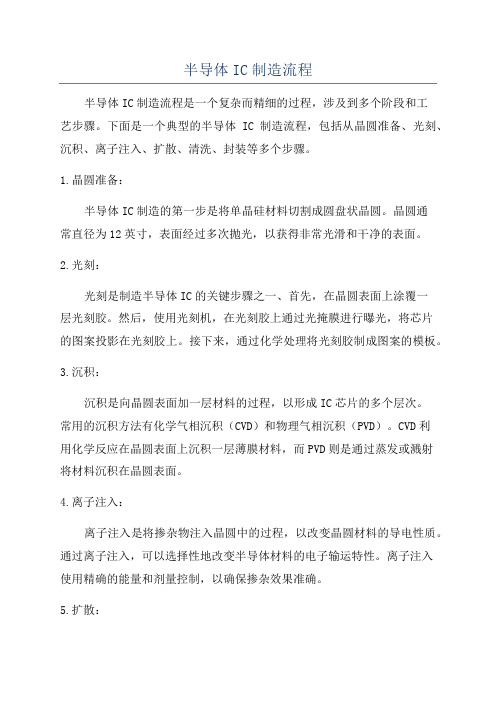
半导体IC制造流程半导体IC制造流程是一个复杂而精细的过程,涉及到多个阶段和工艺步骤。
下面是一个典型的半导体IC制造流程,包括从晶圆准备、光刻、沉积、离子注入、扩散、清洗、封装等多个步骤。
1.晶圆准备:半导体IC制造的第一步是将单晶硅材料切割成圆盘状晶圆。
晶圆通常直径为12英寸,表面经过多次抛光,以获得非常光滑和干净的表面。
2.光刻:光刻是制造半导体IC的关键步骤之一、首先,在晶圆表面上涂覆一层光刻胶。
然后,使用光刻机,在光刻胶上通过光掩膜进行曝光,将芯片的图案投影在光刻胶上。
接下来,通过化学处理将光刻胶制成图案的模板。
3.沉积:沉积是向晶圆表面加一层材料的过程,以形成IC芯片的多个层次。
常用的沉积方法有化学气相沉积(CVD)和物理气相沉积(PVD)。
CVD利用化学反应在晶圆表面上沉积一层薄膜材料,而PVD则是通过蒸发或溅射将材料沉积在晶圆表面。
4.离子注入:离子注入是将掺杂物注入晶圆中的过程,以改变晶圆材料的导电性质。
通过离子注入,可以选择性地改变半导体材料的电子输运特性。
离子注入使用精确的能量和剂量控制,以确保掺杂效果准确。
5.扩散:扩散是在掺杂完成后,通过加热晶圆使其扩散并混合掺杂物的过程。
通过扩散,掺杂物将在晶体中形成预定的浓度梯度。
这是制造晶体管中P-N结的关键步骤。
6.清洗:半导体制造过程中,晶圆表面容易受到污染。
因此,在每个制造步骤之后,都需要对晶圆进行清洗,以去除任何残留物和污染物。
常用的清洗方法包括溶液浸泡、超声波清洗和离子束清洗等。
7.封装:封装是将制造好的IC芯片封装在适当的外壳中的过程。
封装通常包括将芯片连接到引脚(通常通过焊接或压接)、封装芯片和引脚,并保护芯片免受外界环境的影响。
封装也提供了芯片与外部系统的电子连接。
以上所述是一个典型的半导体IC制造流程,仅涵盖了主要的制造步骤。
实际制造流程可能因芯片类型、工艺要求和制造工厂的不同而有所差异。
此外,半导体IC制造流程还包括质量控制、测试和分选等步骤,以确保最终产出的芯片能够满足规格要求。
芯片制造工艺流程9个步骤

芯片制造工艺流程9个步骤
芯片制造工艺流程9个步骤:
1.晶圆清洗:硅晶圆表面必须清洁无尘,通常采用气相清洗、化学腐蚀、超纯水清洗等方法。
2.晶圆沉积:采用化学气相沉积或物理气相沉积等技术,在晶圆表面沉积一层硅氧化物等材料,用于绝缘、隔离等功能。
3.光刻:通过光刻机将芯片电路的图形投影到晶圆表面,用于制造电路的图形结构。
4.电镀或蚀刻:将光刻后未覆盖图形部分的表层材料进行电镀或蚀刻处理,用于形成电路图形结构。
5.清洗:将蚀刻后的晶圆表面进行清洗处理,去除残留的光刻胶和蚀刻液等杂质。
6.注入杂质:通过扩散或离子注入等技术在晶圆表面注入杂质,形成半导体材料的导电区和绝缘区。
7.退火:通过高温处理,使晶圆中的半导体材料达到稳定状态。
8.金属沉积:将金属氧化物等材料沉积在晶圆表面,形成导线、电极等。
9.封装:将芯片进行封装,以便在实际应用中使用。
芯片制造工艺流程

芯片制造工艺流程芯片制造工艺流程是指将芯片设计图纸转化为实际可用的芯片产品的过程。
整个流程包括晶圆加工、光刻、沉积、刻蚀、清洗、离子注入、封装测试等多个环节,每个环节都至关重要,任何一个环节出现问题都可能导致整个芯片的失效。
首先,晶圆加工是芯片制造的第一步,也是最关键的一步。
晶圆是一种薄而圆的硅片,它是芯片制造的基础材料。
在晶圆加工过程中,需要对晶圆进行清洁、抛光和化学处理,以确保晶圆表面的平整度和纯净度。
只有在这样的基础上,才能进行后续的光刻、沉积和刻蚀等工艺步骤。
接下来是光刻工艺,光刻是利用光刻胶和光刻机将芯片设计图案转移到晶圆表面的过程。
通过光刻,可以在晶圆表面形成微细的图案,这些图案将会在后续的沉积和刻蚀过程中发挥重要作用。
然后是沉积工艺,沉积是将各种材料沉积到晶圆表面的过程,以形成各种功能性的层。
在芯片制造中,常用的沉积方法包括化学气相沉积(CVD)和物理气相沉积(PVD),它们可以将金属、氧化物、氮化物等材料沉积到晶圆表面,以满足不同的功能需求。
紧接着是刻蚀工艺,刻蚀是将多余的材料从晶圆表面去除的过程,以形成所需的图案和结构。
刻蚀通常使用化学腐蚀或物理打磨的方法,通过控制刻蚀速率和刻蚀深度,可以精确地调控晶圆表面的形貌和结构。
随后是清洗工艺,清洗是将晶圆表面的杂质和残留物去除的过程,以保证晶圆表面的纯净度和光洁度。
在芯片制造中,清洗工艺尤为重要,因为任何微小的污染都可能影响芯片的性能和可靠性。
之后是离子注入工艺,离子注入是将掺杂剂注入晶圆表面的过程,以调节晶圆的电学性能。
通过控制离子注入的能量和剂量,可以在晶圆表面形成不同的电子器件结构,如栅极、源极和漏极等。
最后是封装测试工艺,封装测试是将芯片封装成最终的产品,并进行性能和可靠性测试的过程。
在封装测试过程中,需要将芯片连接到封装基板上,并进行严格的电气测试和环境测试,以确保芯片在各种工作条件下都能正常工作。
总的来说,芯片制造工艺流程是一个复杂而精密的过程,需要多种工艺步骤的精准配合和严格控制。
- 1、下载文档前请自行甄别文档内容的完整性,平台不提供额外的编辑、内容补充、找答案等附加服务。
- 2、"仅部分预览"的文档,不可在线预览部分如存在完整性等问题,可反馈申请退款(可完整预览的文档不适用该条件!)。
- 3、如文档侵犯您的权益,请联系客服反馈,我们会尽快为您处理(人工客服工作时间:9:00-18:30)。
Chip Manufacturing Process – Deposition 芯片制作过程 – 沉积
SMIC
A layer of silicon dioxide (SiO2) glass is grown on the wafer by exposing the wafer to oxygen at very high temperatures. A process called chemical vapor deposition (CVD) is then used to coat silicon dioxide onto the wafer surface. Because it will not conduct electricity, this layer is called “dielectric”. Later, channels will be etched or otherwise formed in the dielectric for conducting materials. SiO2 may also be grown or deposited during later steps in the process as layers of the circuit are built onto the chips: 制作晶片的第一步是在晶圆上沉积一层不导电的二氧化硅。在晶 片的后续制作过程中,二氧化硅层的成长、沉积会进行很多次。 在高温下使晶圆曝氧可以使二氧化硅层成长。然后使用化学气相 沉积方法使二氧化硅层沉积在晶圆表面。
Chip Manufacturing Process – Electroplating 芯片制作过程– 电路连接
SMIC
The portions of a chip that conduct electricity form the chip’s interconnections. A conducting metal (usually a form of aluminum) is deposited on the entire wafer surface. Unwanted metal removed during lithography and etching leaves microscopically thin lines of metal interconnects. All the millions of individual conductive pathways must be connected in order for the chip to function. This includes vertical interconnections between the layers as well as horizontal Interconnections across each layer of the chip. 进行电连接。导电金属(通常是铝)在晶圆表面沉积。使用光刻 和蚀刻制程去除没有用的金属。现在复杂的晶片都需要很多层绝 缘体。一个正常运作的晶片需要连接数以百万计的传导线路,包 括层上水平连接和各层之间的垂直连接。
What is microlithography?
Microlithography: transfer the pattern of circuitry from a mask to a wafer.
Chip Manufacturing Process – Photolithography 芯片制作过程– 光刻
Silicon Ingot
Chip Manufacturing Overview 光罩制作/光刻 光罩制作 光刻 晶柱 沉积 晶圆 Mask Making/ Deposition 芯片制作概述 Photolithography
Wafer
蚀刻 Etching
离ing
SMIC 0.13u Cu BEOL Flow
1ML DD FLOW
CVD SIN DEP FSG DEP SION DEP VIA PHOTO VIA DRY ETCH VIA CLEAN BARC COATING PLUG ETCH BACK MTOX PHOTO MT DRY ETCH MT CLEAN STOP LAYER REMOVE POST-SLR CLEAN TaN/Ta & Cu SEED CU PLATING M2 CU CMP
Chip Manufacturing Process – Ion Implantation 芯片制作过程– 离子植入
SMIC
To control the flow of electricity through a chip, certain areas of the wafer are exposed to chemicals that change its ability to conduct electricity. Atoms from the chemicals, called doping materials, can be “diffused, ” or forced, into areas of the silicon wafer through chemical exposure and heating. 为了能在晶片上控制电流,加热晶圆,使晶圆部分区域接触添加 剂。添加剂里的原子能够替换晶圆里的部分硅原子来改变其导电 性。
SMIC is currently running 1P6M, 1P8M process
Chip Manufacturing Process – Assembly&Testing 芯片制作过程– 切割、封装
SMIC
Each chip on a completed wafer is tested for electrical performance. Any chips that fail are marked so they can be discarded when sawed into individual dies. The chips are put into individual packages which will protect the chips and provide connections from the chips to the products for which they are designed. For example, chips destined for computers are placed In packaging that can be plugged into computer circuit boards. Once packaged, chips are tested again to make sure they function properly before being shipped to distributors or placed in electronic products. 晶圆上的每一个晶粒都需要进行测试。有缺陷的晶粒被标记起来, 在进行晶圆切割时这些晶粒被剔除。每个晶粒都按要实现功能的 不同进行单独封装。比如要应用在电脑上的晶粒被封装后能够插 入电脑集成电路板。封装好后,在进行最终使用前,晶粒将进行 再一次测试以确保功能正常。
Chip Manufacturing Process – Forming Multiple Layers
芯片制作过程– 生成多层
SMIC
Through several lithography and etch steps, subsequent layers of various patterned materials are built up on the wafer to form multiple layers of circuit patterns on a single chip. 经过几次光刻与蚀刻步骤,在晶圆表面叠 加成多层不同图案
Chip Manufacturing Process – Etching 芯片制作过程– 蚀刻
SMIC
The wafers exposure to light in lithography causes portions of the resist to “harden” (or become resistant to certain chemicals). The “non-hardened” resist is washed away. Then the material below it, for example SiO2, is etched away. Finally, the “hardened” resist is stripped off so that the material underneath forms a three-dimensional pattern on the wafer. The first lithography and etch process will result in a pattern of SiO2. 光刻制程后,感光部分的光刻胶具有强的抗腐蚀性,抗腐蚀性 弱的光刻胶在接下来的制程里被洗去。接着光刻胶下面的部分 被蚀刻制程除去。最后,抗腐蚀性强的光刻胶也被剥离。 光刻与蚀刻制程在晶圆表面形成3D的图案。
Introduction of the Semiconductor Packages and Assembly Package Types and Applications (1)
Raw Material for Wafers (Cont’d) 晶圆制作所需原料 (接上页)
To remove the tiniest scratches and impurities, one side of each wafer is polished to a mirror-like surface. Chips are built on this surface. 切下的晶圆要经过清洁、磨光等步骤以去 除杂质,使平面光滑。
